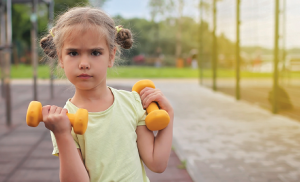Your young athlete plays seasonal sports and goes on spontaneous bike rides with his friends. But when he approaches you with the question, “Can I work out with you, Dad?” How do you know if he is ready? Greg Myer, Ph.D., director of research, Division of Sports Medicine at Cincinnati Children’s Hospital Medical Center, says kids can begin resistance exercises at a young age, although it depends on the child.
“It has a lot to do with their capacity to take instruction; some kids are ready to do more advanced things when others aren’t,” says Myer. “As they build their training age and show their moving competence, then you can start adding external resistance,” he adds.
Resistance training doesn’t necessarily mean adding external resistance — there are plenty of body weight exercises for younger kids to try, and you can keep it interesting and fun, too.
Worried resistance training may stunt your kids’ growth? This old wives’ tale is well, just an old wives’ tale, according to Matthew Busam, M.D., Mercy Health orthopedic and sports medicine surgeon and chief medical officer for FC Cincinnati.
“All the research indicates that resistance training exercises do not harm children’s growth plates therefore there is no evidence that resistance training can stunt a child’s growth,” he says. “Resistance training can benefit a child by improving strength, coordination and overall physical fitness.”
Try teaching your kids physical movement and competence using animal positions, for example, such as acting like a bear or rabbit to get them to hop. Your active child will learn various movements while staying engaged. So start training your child right now, and build as he grows.
Physical Development
You may notice your tiny tot jumping on and off the couch. This is him naturally building his strength and he doesn’t even know it.
Girls’ physical development happens a bit earlier than boys due to their neuromuscular growth and activity (puberty), according to Myer, but boys and girls can begin physical activity as soon as they are ready and able, which plays a huge role in their health, now and in later years.
The problem with a kid not being physically active, is that he is not building skill sets such as jumping, landing, pulling and climbing, Myer says.
“Those skill sets are not being developed like they used to be and development is highly correlated with physical activity,” he adds.
A child’s physical development requires a variety of movements and skills, and sports’ specialization plays a huge role in this, which is why sports for kids are so huge.
“Body weight exercises include push-ups, air squats and sit ups,” suggests Busam. “Well-trained and certified personal trainer’s are available at most commercial gyms and YMCA’s or recreation centers.”
Strength is the foundation for introducing physical activity to your child. If you have questions, consult a strength coach or physical therapist for guidance.
LET’S GET PHYSICAL!
• WALK OR RUN IT OUT
This is a great way to get the family out and active together. If your kid watches you, encourage him to join in.
• GO BACK TO CHILDHOOD
Remember when four-square and hopscotch were popular? Introduce it to your kids. Jumping and hand-eye coordination help physical development and build agility.
• SWITCH IT UP
Variety helps to keep a kids’ attention. Play games that involve running, then do a family pushup challenge for fun. Kids won’t even realize they just completed a cardiovascular and strength workout!
• SET AN EXAMPLE
Monkey see, monkey do: If you get excited about a bike ride or jog and your kids see that, they will look at physical exercise in a positive way and just may follow right along.





